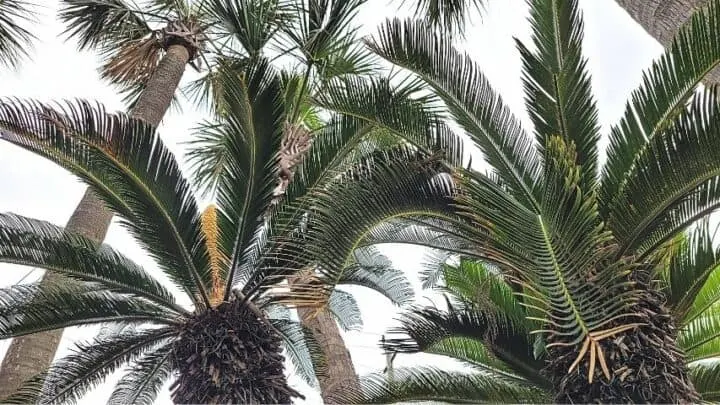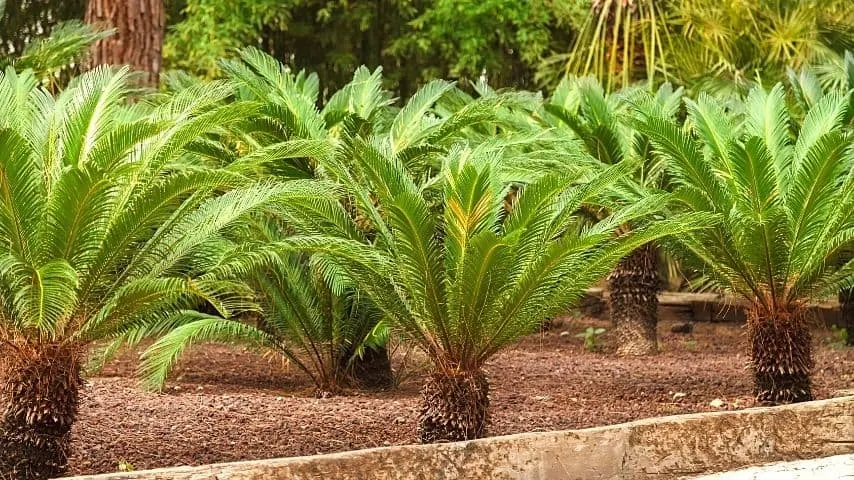The Sago Palm (Cycas Revoluta) is a posh plant renowned for its leathery features and low maintenance.
This is an excellent plant for beginners and is an exciting add-on to nearly any room.
The name of Sago Palm may indicate that it is a palm, but it is rather a Cycad. It is among the ancient classes of plants, counting back to the prehistoric era.
While it is a very easy plant to take care of, not taking proper care of the leaves can cause problems, mainly browning of leaves.
Table of Contents
Sago Palm Brown Leaves
Brown leaves on Sago palms can be caused by nutrient deficiencies, root rot, and insect and pest invasions. Transplant shock, too much sunlight, cold temperatures, and overfertilization are other factors that can lead to brown leaves on Sago palms.

Why Does My Sago Palm Have Brown Leaves?
8 Causes of Browning on Sago Palm Leaves
1. Supplement Inadequacy
Manganese inadequacy in the soil can prompt Sago Palm ends to change from brown to yellow and hinder new growth for the plant.
If the center of the leaf remains green, but there is a brown band around it, your Sago Palm may have a magnesium deficiency.
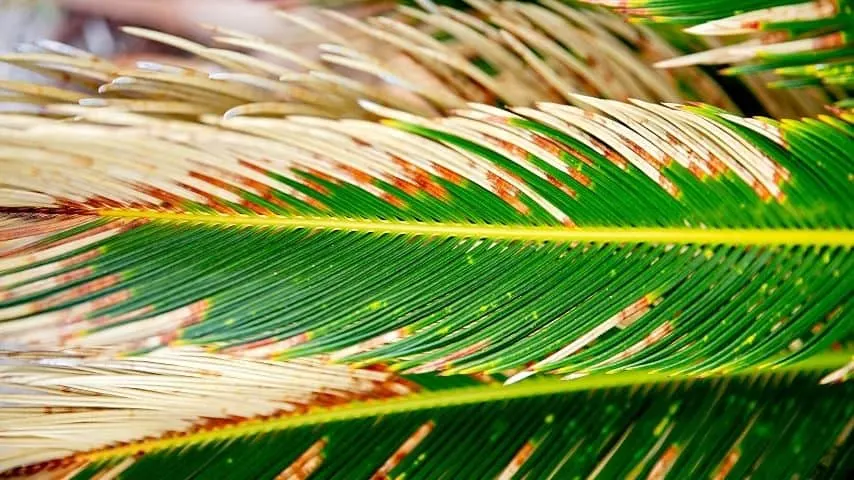
If you notice a brown band forming on your Sago Palm’s leaves, it’s a sign of manganese inadequacy
2. Root Rot
The soil that does not drain well will cause problems for your Palm’s foliage. The color of the leaves changes, and the tips begin to turn brown.
Sago Palm dies because of rot, and poor drainage is the leading cause of rot. No drainage hole in the pot can trigger root problems that lead to the browning of leaves.
The root system of plants must be closely reviewed for any indications of root rot. The rotten roots will be crumpled or become dark brown in color as opposed to a nutritious, whitish light brown color.
3. Improper Light
Giving too much light may lead to dry, scorched leaves, especially for newly planted Sago Palms. This will weaken its leaves and make them turn brown.
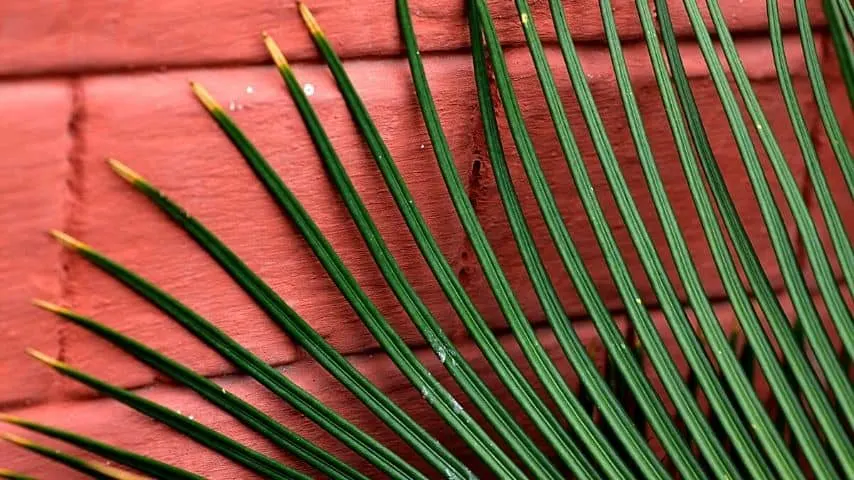
Placing your Sago palm in areas with too much light can lead to its leaves being scorched or brown
Brown tips can also develop when the plant is kept in an extremely dark spot. In severe cases, fronds might wilt and decline prematurely.
4. Over Fertilizing
Overfertilization can make Sago leaves turn earthy colors. Make certain to read the manure’s rules completely and cling to them.
Overfeeding can trigger the development of inorganic substances that are harmful to the healthy growth of Sago Palms. Alkaline soil can also turn the tips of Sago Palm leaves brown.
When this happens, the ends of the foliage become stained, turn earthy-colored, and twist.
5. Cold Temperature
The Sago Palm is very hardy and can withstand temperatures ranging from 15 to 110 degrees Fahrenheit (-9.4 to 43 degrees Celsius).
Even though Sago Palm can endure cold temperatures, too much of it can be bad for the plant.
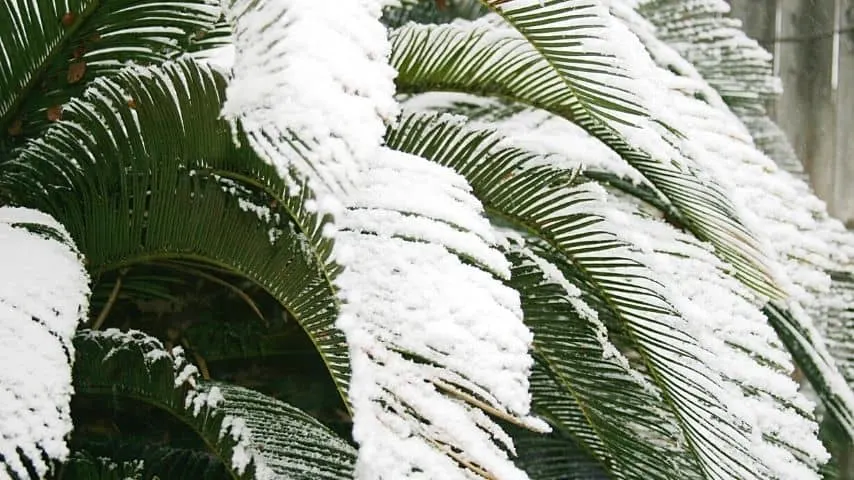
Though your Sago Palms can endure cold temperatures, it can lead to leaf browning
A chilly climate can trigger the foliage of Sago Palm to turn brown. This occurs because the roots can’t take up supplements from the ground in such conditions.
There is not enough water to transfer the nutrients to the foliage. Leaves may freeze and turn yellow or earthy colored.
6. Transport Shock
Disturbance can turn leaves brown. If you frequently move the plant from one place to another, you must be prepared for at least some leaves turning brown.
Instead of aggravating the plant, ensure you put it in the right place on the first few tries.
7. Spider Mites
Spider mites are also a culprit behind brown leaves. These pesky pests attack both indoor and outdoor plants frequently.
These insects suck the nutrition of the plant and weaken it, which results in brown leaves.
You’ll find the first signs of a spider mite infestation pest on the underside of the leaves. If you find brown spots, you need to take immediate action.
8. Aulacaspis Scale
Aulacaspis scale (Aulacaspis Yasumasa Takagi) is an insect that often preys upon Sago Palms.
If your plant is infected by these insects, the leaf of the plant will develop yellowish spots.
The Aulacaspis scale is white and waxy, which makes it very easy to detect. A dense infestation of the Aulacaspis scale can trigger the leaves to turn brown and stunt new growth.
Solution for the Brown Leaves on Sago Palm
Fixing Supplement Inadequacy
This can be remedied by providing the Sago palm with a great soil mix.
You can splash manganese on the leaf surface, as the brand recommends. When you find new green leaves, you should cut off the brown leaves so that your plant can grow healthy.
Treating Root Rot
Replanting the plant in new soil with excellent drainage is suggested to prevent standing water and fix root rot.
Having drainage holes in the pot in which you plant a Sago Palm will be beneficial.
It is also advised to tenderly wash rotten roots and eliminate all mushy, soft parts with a disinfected pair of scissors or an instrument such as a pulaski for larger roots.
Maintaining Proper Light
Sago Palm does best when it has good sunlight to enjoy. Hence, placing your Palm close to a south-facing window is best.
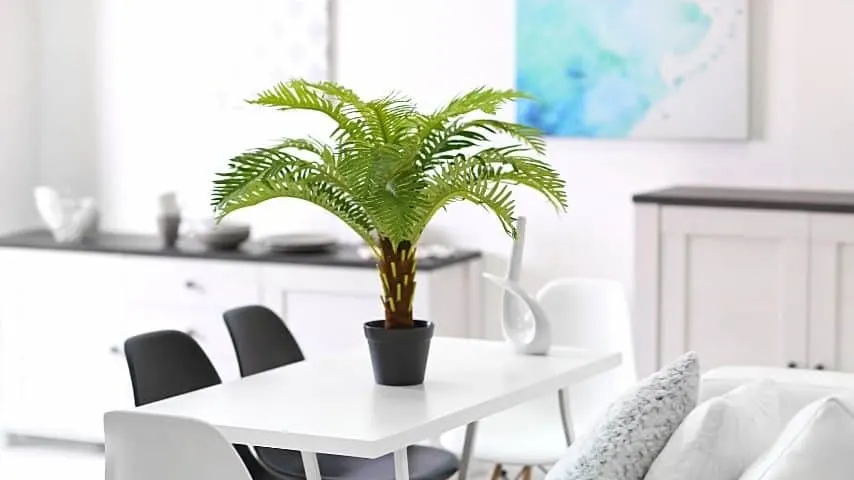
Ensure to place your Sago Palm near a south-facing window for it to get bright light with partial shade
It is safest to put your Sago Palm in a spot with a bright light and partial shade. You’ll get bigger leaves with healthier colors if you place your Sago palm in this environment type.
Proper Fertilization
The Sago Palm needs occasional fertilizing with a slow-release 8-8-8 balanced plant food.
Choose a slow-release fertilizer for Sago Palm, as it will gradually fertilize the plant, preventing salt build-up.
It is also advised to have micronutrients in the fertilizer formula.
Treating Cold Damage
The only option is to wait for warmer weather when leaves turn brown due to cold weather.
Let the dead foliage stay where they are until the climate warms up slightly, and chop off every one of the leaves from the trunk.
New leaves will soon take their spot.
Getting Rid of Pests
To get rid of spider mites, mix three tablespoons of dish soap with a gallon of water. Spray this soapy solution on the infected leaves weekly or as required.
Rubbing alcohol is also a good solution. Dip the cotton ball in rubbing alcohol so you can wipe the Sago palm’s foliage infected with spider mites.
Removing Aulacaspis Scale
It is recommended to wash the Aulacaspis scale off with a powerful, direct stream of water. You might have to get rid of severely infected leaves.
You can also spray the Sago Palm with horticultural oil. Apply it every 10 to 21 days, depending on the brand suggestions.
Frequently Asked Questions about Sago Palm Having Brown Leaves
Should you cut off brown Sago Palm leaves?
Sago Palm restores their leaves throughout its growing season. Chop the leaves that are entirely brown or yellow at the base. Ensure that you do not pull the leaves, as this can harm the healthy parts of the plant.
Can brown Sago Palm leaves turn back to green?
Completely brown leaves are dead, they will not turn green again. However, if only some part of the leaf is brown, check the water supply, sunlight exposure, and nutrient levels of the leaf. There’s a possibility of reviving the brown leaves.

Daniel has been a plant enthusiast for over 20 years. He owns hundreds of houseplants and prepares for the chili growing seasons yearly with great anticipation. His favorite plants are plant species in the Araceae family, such as Monstera, Philodendron, and Anthurium. He also loves gardening and is growing hot peppers, tomatoes, and many more vegetables.

